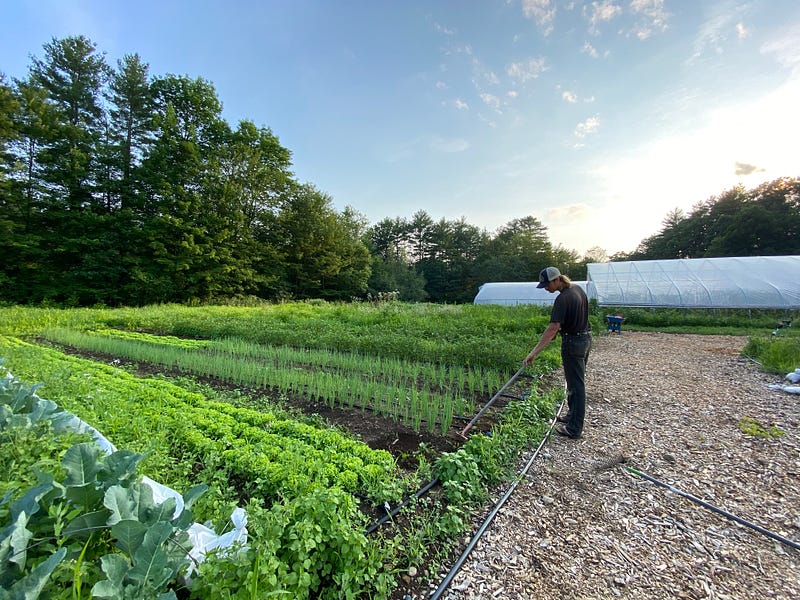The Soil-Gut Nexus: Nourishing Health Through Nature's Cycles
Written on
Chapter 1: Understanding the Soil-Gut Relationship
Where does our gut health originate? To find the answer, we must trace back to its roots. The connection between soil and our digestive systems is profound, with researchers often describing our gut microbiome as an internal garden. As agricultural practices degrade the external garden—our soil—the health of our internal garden likewise deteriorates.
The Terminology of Soil vs. Dirt
When individuals think of soil, they typically envision dirt. This perception not only discredits soil scientists and regenerative farmers but also reflects a troubling reality. The term "dirt" carries negative implications, evoking images of lifeless, brown dust that clings to our shoes. Yet, healthy living soil is being rapidly transformed into barren dirt, with an alarming loss of approximately 30 soccer fields worth of productive soil every minute due to agricultural chemicals, tilling, machinery, and erosion. Meanwhile, our digestive health faces numerous challenges.
In this exploration, we will delve into:
- The human gut microbiome (our internal garden)
- The soil microbiome (the external garden)
- The impact of soil health on human health
- Methods to enhance biodiversity both inside and outside our bodies
- How robust soil contributes to better gut health

The Internal Garden: Microbes as Our Digestive Allies
Our gastrointestinal system comprises various organs, including the mouth, esophagus, liver, gallbladder, stomach, small intestine, and large intestine, which hosts trillions of microorganisms. Researchers often consider the microbiome an essential organ, as crucial to our health as the heart or lungs. It’s estimated that the human GI tract is home to over 100 trillion microbes, predominantly residing in the colon.
These microorganisms are vital, not only for digesting food and extracting nutrients but also for influencing energy levels, mental health, immune function, hormonal balance, and the risk of chronic diseases. Thus, the gut microbiome is fundamental to our overall health.
The External Garden: Soil as Plants' Digestive System
While humans possess an internal microbial digestive system, plants rely on soil as their external digestive system. The rhizosphere, or root zone, of healthy soil contains a staggering number of microorganisms, comparable to those in the human gut, but with greater diversity. Plants produce their own food through photosynthesis but allocate a significant portion of their sugars—30-40%—to the microbes in their root zone. These microorganisms, in turn, help extract essential nutrients from the soil, much like gut microbes break down food for our bodies.
The Deteriorating Nutritional Landscape
As our soils degrade, the nutritional quality of our food diminishes. Biodiversity, both in soil and in our diets, has been declining significantly. The widespread application of synthetic fertilizers, pesticides, and machinery in modern agriculture has led to the loss of rich soil ecosystems, which, in turn, impacts the diversity of our gut microbiomes.
The consequences are severe: a lack of microbial diversity in our diets correlates with a decline in gut health.
Earth Talk: How Do Soil Health and Gut Health Interact? with Jane Gleeson - This video explores the intricate relationship between soil health and gut microbiome health.
The Importance of Biodiversity
A diverse gut microbiome serves as our primary defense against harmful organisms. More biodiversity within our gastrointestinal tract leads to greater resilience against potential threats. However, lifestyle choices, such as a diet high in processed foods and sugars, can disrupt this balance, leading to dysbiosis—an imbalance in gut flora.
Dysbiosis has been linked to numerous modern health issues, including chronic fatigue, heart disease, autoimmune conditions, and various gut disorders. Just as ecosystems depend on biodiversity for resilience, our gut microbiome thrives on it too.
Monoculture and Its Consequences
Industrial agriculture has increasingly favored monocultures, which involve growing a limited number of crop species. This practice not only depletes the diversity of our food supply but also mirrors a reduction in diversity within our own guts. The economic risks associated with monocultures highlight the need for diverse agroecosystems that are more productive and resilient.
Nourishing Our Gut Through Diet
Diet is crucial for maintaining a healthy gut microbiome. Consuming a wide array of real foods grown in healthy soils is essential. Local farmer's markets or Community Supported Agriculture (CSA) programs that prioritize organic and regenerative practices are ideal sources of such food.
Ultimately, the health of our soil directly influences the quality of our gut microbiota. Fresh, organic produce, nuts, seeds, fermented foods, and responsibly sourced animal products are key to fostering a flourishing microbiome.
The Interconnectedness of Life
Nature operates as an interconnected web, where every element ties back to the soil. The condition of our internal garden reflects the health of the external garden. The actions we take concerning soil health inevitably affect our own well-being.
Follow me on Medium and Instagram for more insights into microbiomes, gut health, natural living, organic food, and regenerative agriculture.